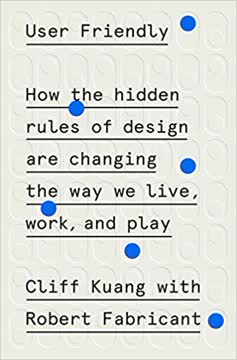Key Takeaways
1. Front-end Architecture emerges as a critical discipline in web development
Front-end Architecture is a collection of tools and processes that aims to improve the quality of our front-end code while creating a more efficient and sustainable workflow.
Historical context: The web has evolved from simple HTML pages managed by webmasters to complex applications requiring specialized roles. As projects grew in complexity, the need for a structured approach to front-end development became apparent. Front-end Architecture addresses this need by:
- Establishing coding standards and best practices
- Implementing efficient workflows and build processes
- Creating scalable and maintainable code structures
- Bridging the gap between design, development, and user experience
Front-end Architecture is not just about writing code; it's about creating a systematic approach to building web interfaces that can adapt to changing requirements and technologies.
2. The role of a Front-end Architect parallels traditional architectural practices
Just like how an Architect spends more time drafting up schematics than pouring concrete, a Front-end Architect's audience is not the end users, but the developers themselves.
Key responsibilities:
- Design: Crafting the overall front-end approach and philosophy
- Planning: Mapping out the development workflow and toolchain
- Oversight: Continuously refining and improving processes
Front-end Architects focus on:
- Creating consistent coding standards
- Implementing efficient build systems and automation
- Developing reusable component libraries
- Ensuring code quality through testing and documentation
This role requires a blend of technical expertise, strategic thinking, and leadership skills to guide the front-end development process effectively.
3. Early involvement of Front-end Architects is crucial for project success
The decisions that can be made at this stage of the game are just too important to overlook to put off until later.
Benefits of early involvement:
- Influence critical decisions that shape the project's architecture
- Align front-end strategies with overall project goals
- Prevent costly rework and technical debt
Challenges to overcome:
- Budget constraints
- Lack of understanding of the role's importance
- Traditional project workflows that delay front-end considerations
Early involvement allows Front-end Architects to:
- Collaborate with designers on feasible and efficient UI solutions
- Work with back-end developers to define optimal data structures
- Set up proper tooling and workflows from the project's inception
By advocating for early involvement, Front-end Architects can significantly impact project efficiency and long-term maintainability.
4. Project Alpha: A case study in implementing Front-end Architecture
Our team was incredibly fortunate to be working with Red Hat at that particular time. Having just launched the original site redesign we were in a bit of a feature moratorium.
Key elements of Project Alpha:
- Modular content based on atomic design principles
- Comprehensive documentation for all stakeholders
- Extensive testing to prevent regressions
- Streamlined processes mirroring git flow
Outcomes:
- Increased development velocity
- Improved code quality and maintainability
- Enhanced collaboration between team members
Project Alpha demonstrated the power of a well-implemented Front-end Architecture by:
- Reducing redundant work through reusable components
- Ensuring consistency through standardized processes
- Enabling rapid iterations and improvements
This case study serves as a powerful example of the benefits of investing in Front-end Architecture, providing tangible evidence to support its adoption in future projects.
5. Modular markup strikes a balance between automation and control
The utopian state that we are all striving for is a situation where every line of HTML in our site is programmatically created, yet we have full control over the templates and processes used to create that markup.
Characteristics of modular markup:
- Programmatically generated for consistency
- Flexible enough to accommodate various content types
- Controlled through easily modifiable templates
Benefits:
- Reduces manual errors and inconsistencies
- Allows for rapid changes across the entire site
- Improves maintainability and scalability
Modular markup approaches, such as BEM or SMACSS, provide:
- Clear naming conventions for easy understanding
- Reusable components that can be combined in various ways
- A balance between specificity and flexibility in CSS
By adopting a modular markup approach, Front-end Architects can create systems that are both efficient to produce and easy to maintain over time.
6. The shift from building pages to creating Design Systems
The sooner that we realize we are no longer building pages, but Design Systems, the sooner we can start to create some amazing things on the web.
Design System components:
- Visual language (colors, typography, spacing)
- UI patterns and components
- Interaction patterns
- Design principles and guidelines
Advantages of Design Systems:
- Consistency across different pages and applications
- Faster development through reusable components
- Easier maintenance and updates
- Improved collaboration between designers and developers
Design Systems represent a fundamental shift in web development by:
- Focusing on scalable, reusable patterns rather than individual pages
- Providing a single source of truth for design and development
- Enabling rapid prototyping and iteration
By embracing Design Systems, Front-end Architects can create more cohesive, efficient, and adaptable web experiences.
7. CSS methodologies shape the relationship between HTML and CSS
There are almost as many CSS methodologies today as there are CSS or JavaScript frameworks. But unlike CSS or Javascript frameworks, which are usually all or nothing, and come with a bit of baggage, a CSS methodology is more of a philosophy about the relationship between HTML and CSS than a structured codebase.
Popular CSS methodologies:
- OOCSS (Object-Oriented CSS)
- BEM (Block, Element, Modifier)
- SMACSS (Scalable and Modular Architecture for CSS)
- Atomic CSS
Key principles across methodologies:
- Separation of structure and skin
- Reusability and modularity
- Naming conventions for clarity
- Reducing specificity conflicts
Choosing a CSS methodology involves considering:
- Project scale and complexity
- Team size and expertise
- Performance requirements
- Maintainability goals
Front-end Architects should evaluate different methodologies and adapt them to fit their project's specific needs, creating a custom approach that combines the best aspects of various systems.
Last updated:
Review Summary
Readers have mixed opinions on Front-End Architecture. Some find it outdated and too specific to Red Hat's design system, lacking broader applicability. Others appreciate its insights on CSS modularity, testing, and performance. The book is criticized for its narrow focus on a single tech stack and insufficient exploration of modern frontend architectures. While some readers value the historical context and software engineering best practices, others find it too basic or irrelevant. The book's usefulness seems to depend on the reader's experience level and specific work environment.
Similar Books
Download PDF
Download EPUB
.epub digital book format is ideal for reading ebooks on phones, tablets, and e-readers.








